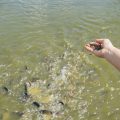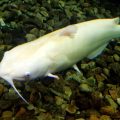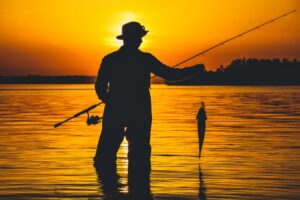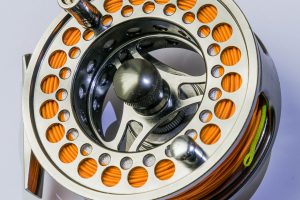Catfish play a role in the water areas ecosystem on our planet. Like most fish their contribution follows them through their lifecycle. From the time a male and female catfish mate and produce fry through the death of those fry who make it all the way to that moment there are benefits on the ecosystem. Being omnivores, as well as prey, this allows catfish to eat and digest plants and animals in their ecosystem which helps to create a balance needed for all forms of life.

What Role Does Catfish Have in Water Areas?
The role of catfish in the water is to be part of the marine ecosystem as they interact closely with their physical, chemical, and biological environment. Like most fish, catfish provide help during their lives and after their deaths. Here is how.
The catfish diet
By eating other organisms, catfish contribute the most to the ecosystem of the water. Since most catfish are omnivorous, they eat whatever comes their way, thus getting rid of pests. Some catfish at the bottom of the water also eat algae and detritus, ich which reduces the level of phosphorus, which helps algae grow.
Algae is an important basic food item for fish; if its number decreases, other fish that depend on algae have less food. This, in turn, decreases the number of other fish necessary to prevent overpopulation in the water. Therefore, the diet of catfish, which incorporates small fish, crabs, snails, algae, and much more, is essential for water ways’ ecosystems.
The catfish as prey
Much bigger fish eat catfish, so they are also important in the food chain underwater. Catfish are integrated into the ecosystem by being the predators, as well as prey.
When the catfish is smaller, it has more predators because it is small enough to be eaten by other fish, but as they grow older, they outgrow many of the predators. Regardless, there are still some other larger fish that eat catfish and get all nutrients from them, such as largemouth bass, smallmouth bass, perch, walleye, striped bass, and pike, which frequently eat young catfish. Other larger catfish also eat smaller catfish.
When the catfish gets bigger, the predators change, and alligators and water snakes become the main predator of catfish. Even outside the water, catfish have predators like raccoons, birds, mink, otters, crocodiles, and large lizards. This means that catfish are included in the ecosystem both inside water areas and on the land.
Once dead, the catfish skeleton in the ocean also acts as food for other smaller fish and crustaceans that can’t attack the fish when it is alive. Thus, acting as a food and nutrient provider for even more organisms.
Indirect participation of catfish in the ecosystem
Catfish is not only important while it is alive in controlling the population of other fish in the water, but it is also important after its death. Most fish remain in the water and slowly decompose, thus releasing nutrients into the area that help algae grow and act as food for other organisms.
The catfish, during its lifetime absorbs a lot of phosphorus and nitrogen, which is useful for supporting the growth of algae and other microorganisms as it is a base food item. Then the catfish travels to different parts of the water and excrete which releases nutrients from its body. The excreted nutrients are readily available for other fish to consume. Phosphorus is very important for strengthening the bones of fish, so it helps the fish get bigger and stronger.
As mentioned above, the catfish then travel to another part of the water and gets eaten or dies naturally. The remains of the fish are scattered on the water floor, which releases nutrients onto the area.
Effect of overfishing catfish
Overfishing catfish can be very bad for the ecosystem. Other invasive species that catfish feed on can increase in number, becoming a problem. Some larger organisms and fish will not have enough food as there are not enough catfish. Moreover, the nutrients will not be able to reach more fish around the ecosystem. Of course, catfish can be pets, but it is important not to catch too many of them. Slowly, it could affect the ecosystem of the waterways.
Effect of freeing pet catfish
Many people free catfish into waterways, thinking they are helping the catfish and the area’s ecosystem. However, this negatively affects the marine ecosystem. This is because catfish live in a specific area, and if introduced into new water, they will not be able to survive and die in no time.
Moreover, even if the catfish is introduced into the right area, it will affect the ecosystem as catfish eat a lot of algae, especially the bottom-feeding ones. As we know, this means they absorb a lot of phosphorus as well, and thus other fish in the water don’t get enough food and phosphorus. A suddenly introduced catfish can consume large amounts of food that were previously eaten by other fish, disrupting the ecosystem.
The catfish can affect the food availability for other fish and decrease their numbers. This is harmful to the fishermen who rely on catching those fish. As we know, there are not many predators of catfish in most waterways, so they can soon become invasive species. This means there needs to be a new predator introduced to decrease the number of catfish, which can be very complicated.
Conclusion
Catfish play an important role in the marine ecosystem as they act as predators, as well as prey. These fish interact with their environment and absorb nutrients, which are then transferred to other organisms in the water. Overfishing of catfish can affect the ecosystem negatively, but so can introducing your pet catfish into random waterways. Catfish can easily become an invasive species.












Pingback: How Hot Would Water Have to Be to Kill a Catfish? | Reel Fishing Guru
Pingback: What is a Gilded Catfish? | Reel Fishing Guru
Pingback: What Is the Difference Between Catfish and Walleye? | Reel Fishing Guru
Pingback: How Light Availability Affects Catfish: A Comprehensive Study | Reel Fishing Guru